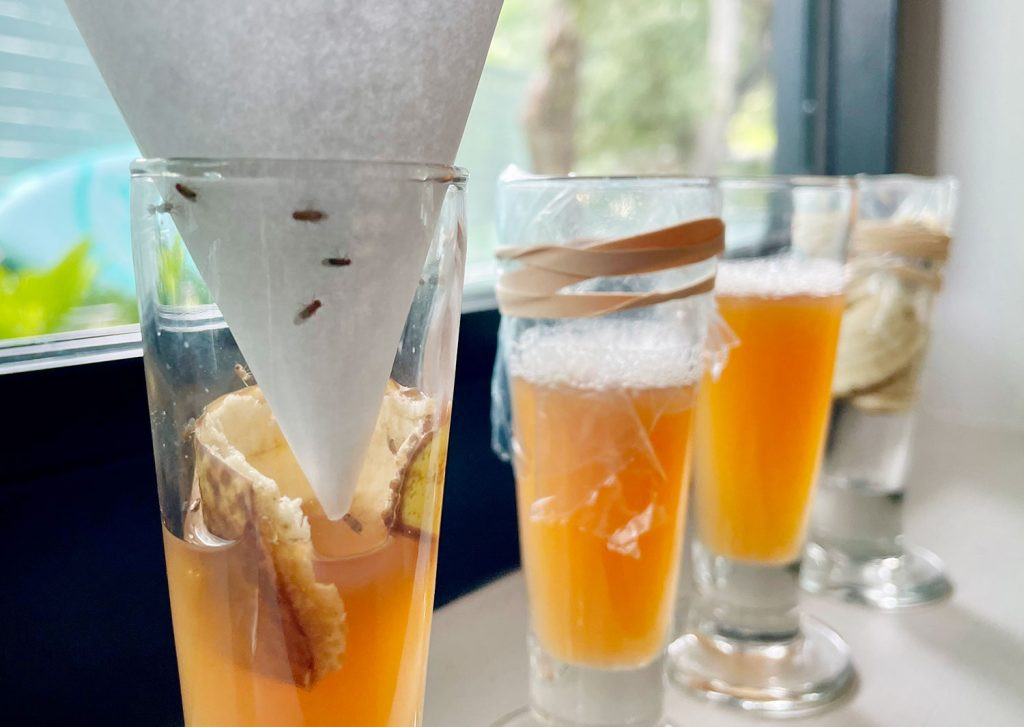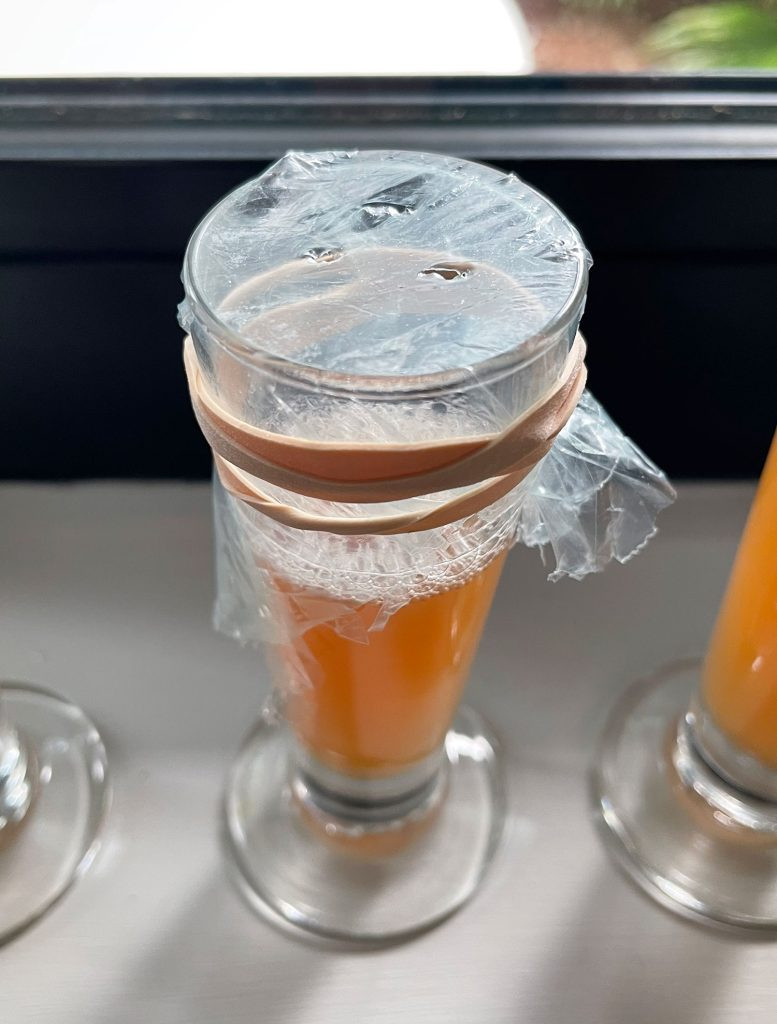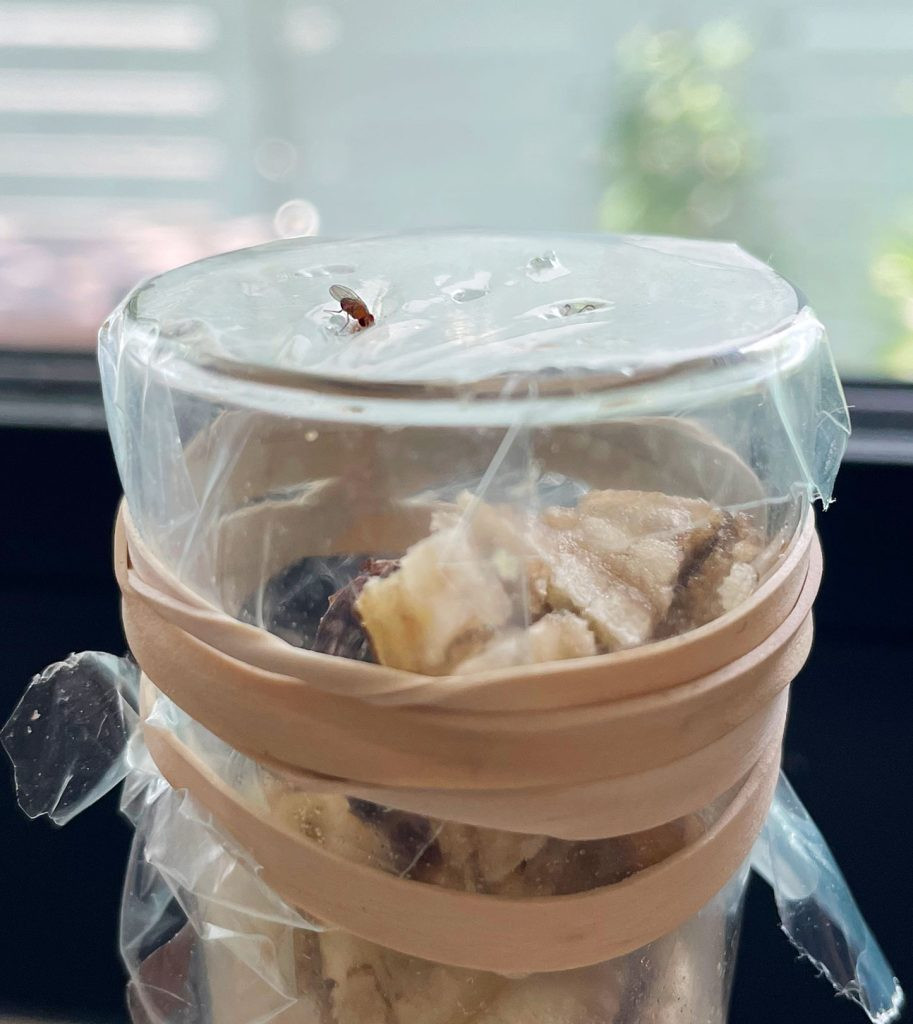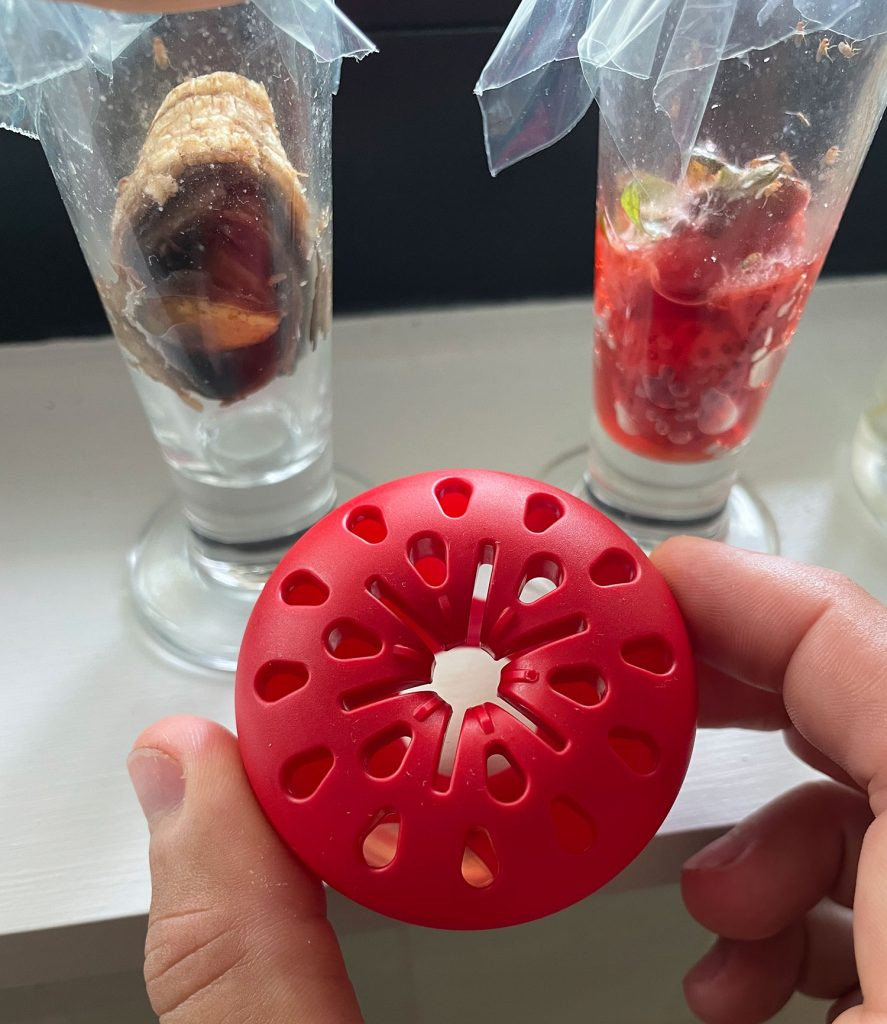Getting rid of fruit flies might seem challenging, but it’s entirely possible. At flyermedia.net, we provide effective methods to eliminate these pests and prevent their return, focusing on simple, readily available solutions that ensure a swift and effective outcome. Discover expert tips and tricks to make your home fruit fly-free.
1. What Exactly Are Fruit Flies?
Fruit flies are small pests attracted to ripe fruits, vegetables, and sugary beverages. They are often confused with fungus gnats and drain flies, but fruit flies resemble tiny flies, thriving around fruit bowls and trash cans. According to a study by the University of Florida, fruit flies are most active during warmer months when fruits ripen.
1.1 How Can You Tell the Difference Between Fruit Flies, Fungus Gnats, and Drain Flies?
Distinguishing between these pests is crucial for effective control. Here’s how to tell them apart:
| Pest | Appearance | Habitat |
|---|---|---|
| Fruit Flies | Small flies, tan or brownish | Near fruit bowls, trash, sugary sources |
| Fungus Gnats | Small mosquitos | Near houseplants, damp soil |
| Drain Flies | Small fuzzy moths | Near sinks and drains |
Identifying them by their appearance and location will help you tailor your approach.
1.2 Why Is It Important to Address a Fruit Fly Problem Quickly?
Fruit flies reproduce rapidly. Females can lay hundreds of eggs that hatch in just 12 hours. Addressing an infestation early prevents a small nuisance from becoming a large, overwhelming problem. Research from the University of California, Davis, shows that controlling fruit flies early significantly reduces their population.
2. What Are Some Effective DIY Fruit Fly Traps?
There are several effective DIY traps you can create using common household items. Each one aims to attract the flies and prevent them from escaping. Here are four popular methods:
- Funnel Trap
- Plastic Wrap Trap
- Dish Soap Trap
- Rotting Fruit Trap
 Fruit Flies Trapped In DIY Funnel Trap Method
Fruit Flies Trapped In DIY Funnel Trap Method
2.1 How Do You Make a Funnel Fruit Fly Trap?
The funnel trap lures fruit flies into a container with a narrow opening, making it difficult for them to escape.
Supplies:
- Small clear jar or container
- Paper or cardstock
- Tape
- Scissors
- Apple cider vinegar
Instructions:
- Choose a Container: Use a small clear jar or plastic bottle, preferably with a narrow opening.
- Add Attractant: Pour apple cider vinegar into the bottom of the container.
- Create a Funnel: Roll paper or cardstock into a cone shape with a small opening at the tip and secure it with tape.
- Set the Funnel: Place the funnel into the container opening, ensuring it doesn’t touch the vinegar and fits snugly to prevent escapes.
- Humane Release (Optional): Carefully take the trap outside, remove the funnel, and let the flies escape.
2.2 What Is the Plastic Wrap Fruit Fly Trap Method?
This trap uses plastic wrap to cover a container, with small holes that allow fruit flies to enter but not exit.
Supplies:
- Small clear jar or container
- Rubber band
- Plastic wrap
- Toothpick
- Apple cider vinegar
 DIY Fruit Fly Trap With Apple Cider Vinegar And Plastic
DIY Fruit Fly Trap With Apple Cider Vinegar And Plastic
Instructions:
- Select a Container: Use a clear jar or container.
- Add Attractant: Pour apple cider vinegar into the container.
- Cover with Plastic: Wrap the opening tightly with plastic wrap and secure it with a rubber band.
- Poke Holes: Use a toothpick to poke a few small holes in the plastic wrap.
- Humane Release (Optional): Take the trap outside, remove the plastic wrap, and let the flies escape.
2.3 How Does the Dish Soap Fruit Fly Trap Work?
This method uses dish soap to disrupt the surface tension of the liquid, trapping fruit flies that land on it.
Supplies:
- Small container, bowl, or dish
- Dish soap
- Apple cider vinegar
Instructions:
- Add Attractant: Fill the bottom of the container with apple cider vinegar.
- Add Dish Soap: Squirt several drops of dish soap into the vinegar and mix.
- Placement: Place the trap where fruit flies are most active.
2.4 Can You Use Rotting Fruit as a Lure for Fruit Flies?
Yes, rotting fruit can be an effective lure. It mimics the natural attraction of fruit flies to decaying organic matter.
Supplies:
- Small jar or container
- Plastic wrap or paper funnel
- Fruit scraps (banana peel, apple slice)
 Fruit Fly Entering Plastic Wrap On DIY Trap
Fruit Fly Entering Plastic Wrap On DIY Trap
Instructions:
- Prepare the Trap: Use either the Plastic Wrap or Funnel trap method.
- Add Fruit: Substitute apple cider vinegar with a piece of banana peel, apple slice, or peach.
- Monitor and Replace: Replace the fruit every day or two to avoid unwanted smells.
3. What Is the Most Effective Lure for Attracting Fruit Flies?
Experimenting with different lures can help you find the most effective one for your situation. Factors such as the type of fruit available and the preferences of the local fruit fly population can influence which lure works best.
3.1 Which Fruits Are Most Attractive to Fruit Flies?
According to our tests, fruit flies are most attracted to strawberries and banana peels. While apple slices are a common choice, they were less effective in our experiment. The riper and more fragrant the fruit, the better it works. A study in the Journal of Economic Entomology supports this, noting that fruit flies are highly attracted to fermenting fruit odors.
3.2 How Do Store-Bought Fruit Fly Traps Compare to DIY Methods?
Store-bought traps are convenient and discreet but may not always be as effective as homemade traps. In our tests, homemade traps using strawberry and banana peel outperformed store-bought options initially. However, store-bought traps can still be effective over time. Terro Traps, for example, can be a good option for long-term control.
 Terro Fruit Fly Apple Trap With No Fruit Flies In It
Terro Fruit Fly Apple Trap With No Fruit Flies In It
4. How Can You Prevent Fruit Flies from Infesting Your Home?
Prevention is the most effective strategy for managing fruit flies. Simple habits can keep these pests at bay.
4.1 What Cleaning Practices Help Prevent Fruit Flies?
Regular cleaning is crucial. Wipe down kitchen surfaces to remove food residue and spills. Promptly clean up fruit juices and alcoholic beverages, as these are highly attractive to fruit flies. According to the EPA, maintaining a clean kitchen is a primary step in pest prevention.
4.2 How Should You Manage Fruit and Produce to Avoid Attracting Fruit Flies?
Dispose of overripe fruit promptly. Wash fruit as soon as you bring it home to remove any eggs or larvae. Store produce in the refrigerator to slow down ripening and reduce the attraction to fruit flies. The FDA recommends these practices to maintain food safety and prevent pest infestations.
4.3 How Important Is Trash Management in Preventing Fruit Flies?
Take out your trash regularly. Food scraps in the garbage can quickly become a breeding ground for fruit flies. Use trash cans with tight-fitting lids to contain odors and prevent access. The USDA advises that proper waste management is essential for preventing pest problems.
4.4 Can Cleaning Sink Drains Help Prevent Fruit Flies?
Yes, cleaning your sink drain can help. Food scraps in the drain can attract fruit flies. Regularly flush the drain with hot water and use a garbage disposal to eliminate organic matter. The CDC recommends regular drain cleaning as part of a comprehensive pest control strategy.
5. What Are Some Common Mistakes People Make When Trying to Get Rid of Fruit Flies?
Avoiding common pitfalls can make your fruit fly control efforts more effective.
5.1 Why Is Identifying the Source of the Infestation Important?
Failing to identify and eliminate the source of the infestation can render your traps ineffective. Fruit flies breed in decaying organic matter, so finding and removing these sources is crucial. According to a study by the University of California, Riverside, focusing on source reduction is the most effective long-term strategy.
5.2 How Does the Type of Attractant Affect Trap Effectiveness?
Using the wrong attractant can reduce the effectiveness of your traps. Experiment with different lures to find what works best in your environment. Remember, fruit flies are attracted to fermenting sugars, so using ripe or slightly rotten fruit can be more effective than store-bought solutions.
5.3 What Role Does Consistent Trap Maintenance Play?
Neglecting to maintain your traps can lead to reduced effectiveness. Regularly clean out and replenish your traps to keep them working optimally. Over time, the attractant may lose its potency, or the trap may become too full, making it less effective.
6. What Are the Best Commercial Products for Fruit Fly Control?
When DIY methods aren’t enough, several commercial products can help manage fruit fly infestations.
6.1 What Are Some Effective Over-the-Counter Fruit Fly Traps?
Several over-the-counter traps are designed specifically for fruit flies. These traps often use a combination of visual and olfactory attractants to lure and trap the flies. Popular brands include Terro, RESCUE!, and Trappify. These traps can be particularly useful in areas where DIY methods are impractical.
6.2 Are There Any Insecticides Safe to Use Around Food Preparation Areas?
When using insecticides, it’s crucial to choose products that are safe for use around food preparation areas. Look for products labeled for indoor use and specifically designed for fruit flies. Always follow the manufacturer’s instructions carefully. Products containing pyrethrins or insecticidal soap can be effective and relatively safe when used correctly.
6.3 How Can You Use Aerosol Sprays for Fruit Fly Control?
Aerosol sprays can provide quick knockdown of fruit flies, but they should be used sparingly and with caution around food preparation areas. Choose a product labeled for flying insects and follow the directions carefully. Be sure to ventilate the area after spraying. According to the EPA, proper application and ventilation are essential when using aerosol insecticides.
7. What Are Some Advanced Strategies for Eliminating Persistent Fruit Flies?
If you’re dealing with a persistent infestation, more advanced strategies may be necessary.
7.1 How Can You Use a Shop Vacuum to Catch Fruit Flies?
A shop vacuum can be an effective tool for catching large numbers of fruit flies. Simply use the vacuum to suck up flies as you see them. This method is particularly useful in areas where fruit flies are concentrated, such as around fruit bowls or trash cans.
7.2 What Role Does Professional Pest Control Play in Severe Infestations?
In severe cases, professional pest control may be necessary. Pest control professionals have access to specialized products and techniques that are not available to the general public. They can also help identify and address underlying issues that contribute to the infestation.
7.3 How Can You Prevent Fruit Flies in Commercial Settings?
Preventing fruit flies in commercial settings requires a comprehensive approach. Implement strict cleaning protocols, maintain proper waste management, and regularly inspect for potential breeding sites. Consider using commercial-grade traps and professional pest control services to maintain a fruit fly-free environment.
8. How Do Weather and Seasonal Changes Affect Fruit Fly Populations?
Understanding the impact of weather and seasonal changes can help you anticipate and manage fruit fly populations more effectively.
8.1 Why Are Fruit Flies More Common in Summer and Fall?
Fruit flies are more common in summer and fall due to the abundance of ripe fruits and vegetables. Warmer temperatures also accelerate their life cycle, leading to rapid population growth. The University of California, Davis, notes that fruit fly activity peaks during harvest seasons.
8.2 How Can You Adjust Your Control Strategies During Peak Seasons?
During peak seasons, increase the frequency of cleaning and maintenance to prevent infestations. Set up traps proactively and monitor them regularly. Store fruits and vegetables in the refrigerator whenever possible. By taking these steps, you can minimize the impact of seasonal increases in fruit fly populations.
8.3 What Role Does Climate Play in Fruit Fly Infestations?
Climate plays a significant role in fruit fly infestations. Warm, humid climates are particularly conducive to fruit fly reproduction. Areas with mild winters may experience year-round fruit fly activity. Adjust your control strategies based on your local climate and seasonal conditions.
9. What Are the Health Risks Associated with Fruit Flies?
While fruit flies are generally considered a nuisance pest, they can pose some health risks.
9.1 Can Fruit Flies Spread Diseases?
While fruit flies are not known to directly transmit diseases to humans, they can pick up and spread bacteria and pathogens from contaminated surfaces. This is particularly concerning in food preparation areas. Proper sanitation and pest control can minimize this risk. The CDC emphasizes the importance of preventing pest access to food to reduce the potential for contamination.
9.2 Are Fruit Flies Harmful to Plants?
Fruit flies are not typically harmful to plants, but their larvae can damage ripening fruits and vegetables. In commercial agriculture, fruit fly infestations can lead to significant crop losses. Protecting your produce from fruit flies can help maintain the quality and yield of your harvest.
9.3 How Can You Minimize Health Risks Associated with Fruit Flies?
To minimize health risks, maintain strict sanitation practices, control fruit fly populations, and protect food from contamination. Wash fruits and vegetables thoroughly before consumption. Store food properly to prevent pest access. By following these guidelines, you can reduce the potential for health problems associated with fruit flies.
10. What Are Some Common Myths About Fruit Flies and Their Control?
Separating fact from fiction can help you make informed decisions about fruit fly control.
10.1 Do Fruit Flies Only Feed on Fruit?
While fruit flies are attracted to fruit, they also feed on other sources of fermenting sugar, such as beer, wine, and vinegar. They can also breed in drains and garbage disposals where organic matter accumulates. Addressing all potential food sources is essential for effective control.
10.2 Can You Eliminate Fruit Flies Simply by Cleaning?
Cleaning is an important step in fruit fly control, but it may not be enough to eliminate an existing infestation. While cleaning removes potential food sources, it does not address flies that have already laid eggs. Combining cleaning with trapping and other control methods is necessary for complete elimination.
10.3 Are Store-Bought Traps Always More Effective Than DIY Methods?
Store-bought traps are not always more effective than DIY methods. In some cases, DIY traps using ripe fruit or vinegar may be more attractive to fruit flies. Experiment with different methods to find what works best in your environment.
Navigating the world of aviation and dealing with pests like fruit flies share a common thread: attention to detail and proactive measures. Just as pilots and aviation professionals meticulously adhere to safety protocols and stay updated with the latest industry news, effective fruit fly control requires a keen eye for potential breeding grounds and a proactive approach to prevention.
For aviation enthusiasts and professionals alike, flyermedia.net offers a wealth of information, from flight school directories and aviation news to career opportunities and tips for air travel. Whether you’re seeking the best flight schools in the U.S., staying informed on aviation regulations, or exploring pilot career paths, flyermedia.net is your go-to resource.
Call to Action
Ready to keep your home and workspace fruit fly-free? Visit flyermedia.net for more tips and resources on pest control, plus a wealth of information on aviation news, flight schools, and career opportunities. Start your journey towards a cleaner, pest-free environment and explore the exciting world of aviation today! Visit flyermedia.net at Address: 600 S Clyde Morris Blvd, Daytona Beach, FL 32114, United States or call us at Phone: +1 (386) 226-6000.
